The network access control market is estimated to be valued at US$ 5.20 Bn in 2025 and is expected to reach US$ 20.92 Bn by 2032, growing at a compound annual growth rate (CAGR) of 22.0% from 2025 to 2032.
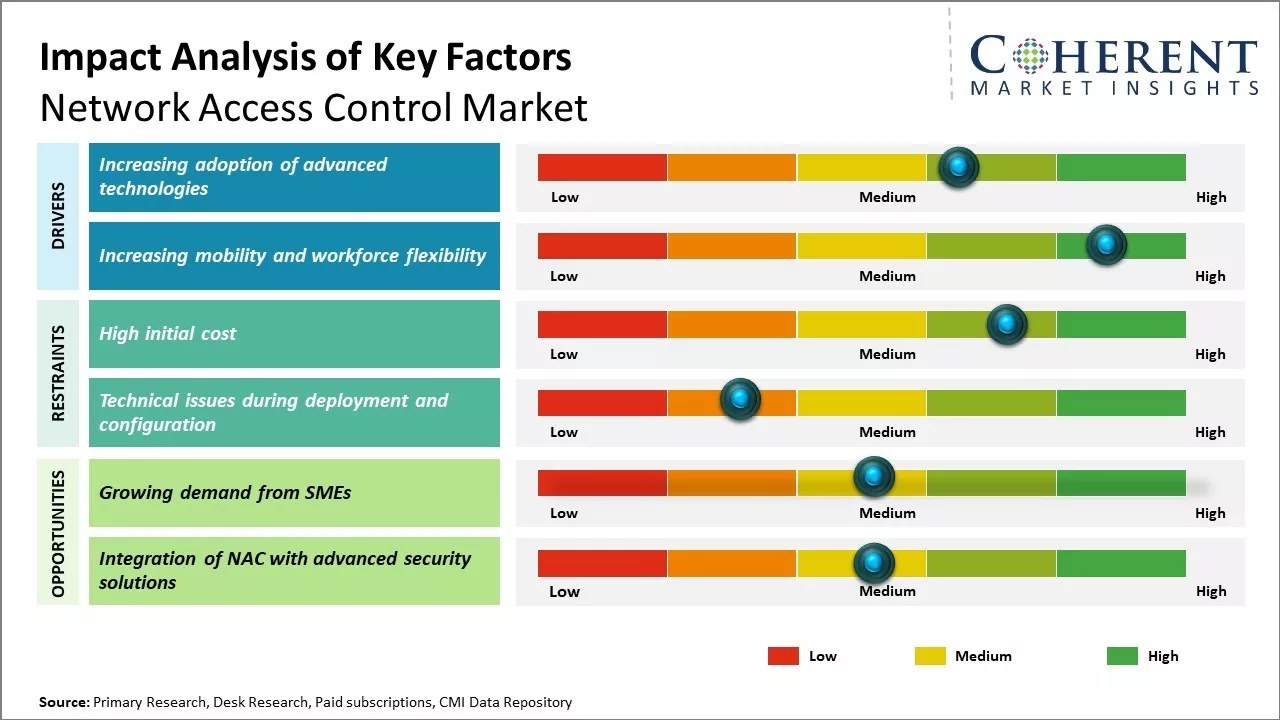
Discover market dynamics shaping the industry: Download Free Sample
NAC solutions enable organizations to reduce the risk of security breaches and data theft by accurately identifying and authenticating users and devices before granting them access to corporate networks and applications. With more employees and contractors working remotely, the demand for effective network access control and monitoring solutions is growing significantly among enterprises of all sizes.
The network access control market is witnessing significant growth in adoption rates driven by increasing security concerns of enterprise networks. Stringent data security and privacy compliance mandates across industries are also propelling more organizations to leverage NAC solutions. With Bring Your Own Device (BYOD) trends and use of personal devices for work growing rapidly, implementing network access control has become imperative for organizations to minimize vulnerabilities. Furthermore, integration of NAC with advanced capabilities like zero-trust network access and Secure access service edge is expected to drive higher revenue opportunities for market players over the forecast period.
Increasing adoption of advanced technologies
As new technologies are emerging at a rapid pace, organizations across industries are embracing digital transformation at an unprecedented scale. Advanced technologies such as Internet of Things, cloud, mobility, and big data are revolutionizing business models and driving compelling opportunities for growth. However, they are also introducing new security challenges that need to be addressed effectively. With more endpoints and a widely distributed workforce relying on various devices and networks to access critical enterprise resources, the attack surface has expanded considerably. Traditional perimeter-based security measures are unable to provide adequate protection in current complex IT environments. There is a growing need for contextual awareness of each device or user trying to access the network along with continuous monitoring of identity and behavior. Network access control has emerged as a promising solution to meet these dynamic security requirements.
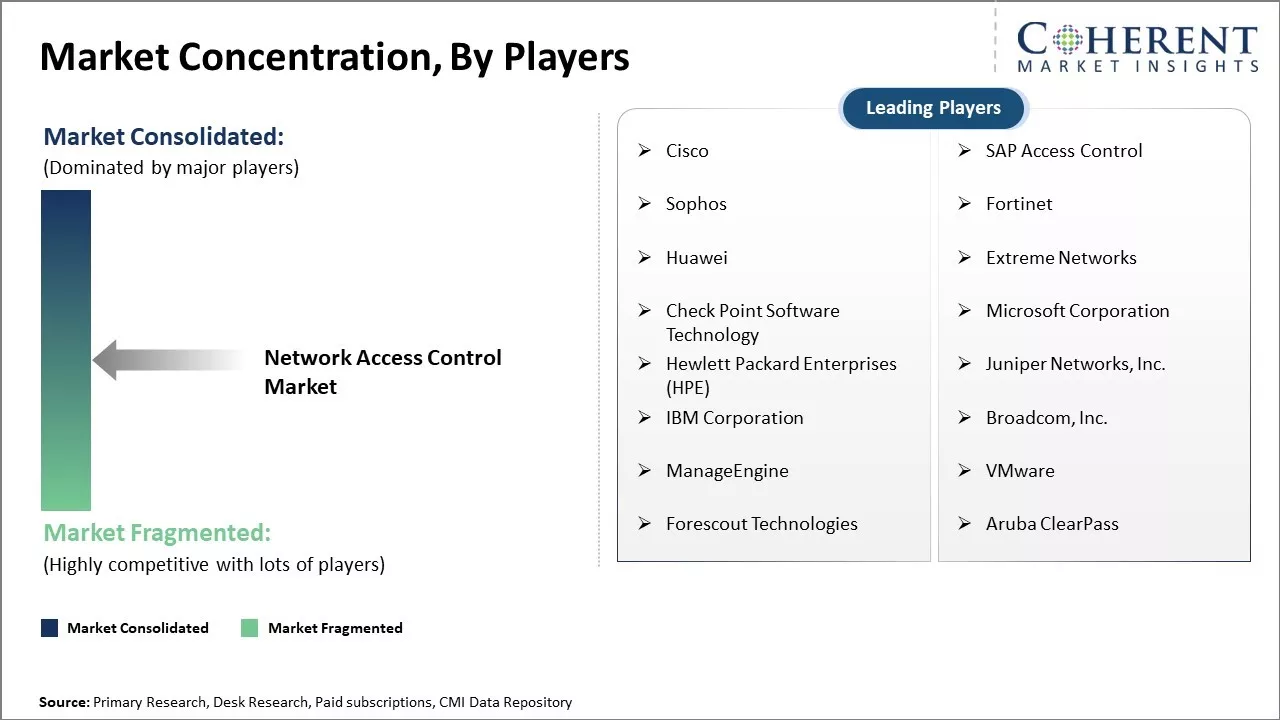
Get actionable strategies to beat competition: Download Free Sample
Increasing mobility and workforce flexibilityWith remote and flexible working becoming mainstream amid the pandemic, maintaining security control over a widely distributed workforce on various personal devices has posed significant challenges for organizations. Mobile workers need seamless yet secure access to collaborate internally as well as engage with partners and customers anytime from anywhere. However, allowing unregulated access also risks unauthorized usage and data leakage. Companies are therefore focusing on implementing zero trust principles and establishing a consistent identity and access management framework to authenticate, authorize, and assure each connection and transaction. Network access control fits well into such an environment with its ability to deliver granular, risk-based access based on dynamic device posture, authentication, and authorization checks. It evaluates every request against robust security posture policies to determine access on a session level. This brings much-needed flexibility, agility, and security to support modern workforce demands.
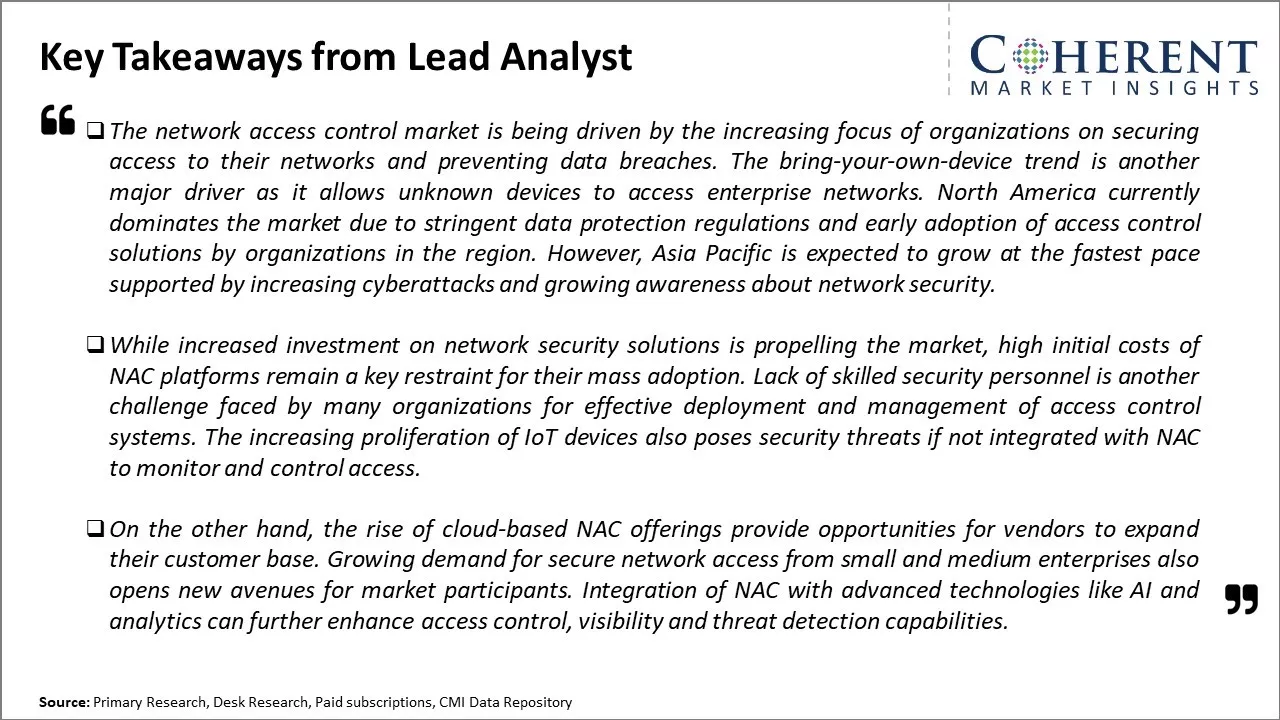
To learn more about this report, Download Free Sample
Market Challenges: High initial costAs more employees become mobile and work from various devices both corporate-owned and personal, it is difficult for organizations to maintain visibility and control over all endpoints on their network. Additionally, the rise of cloud applications and infrastructure brings new devices onto networks that need to be secured. Legacy network access control solutions also struggle to keep up with rapid adoption of new technologies and the increasing sophistication of cyber threats.
Market Opportunities: Growing demand from SMEs
The need for security as networks expand provides the potential for continued growth. More employees working remotely due to the pandemic has heightened the need for robust access management. New technologies like zero trust network access open opportunities for vendors to provide innovative solutions. Additionally, migration to the cloud and integration with software-defined perimeter security creates demand for products that ensure only authorized users and devices can access business-critical applications.
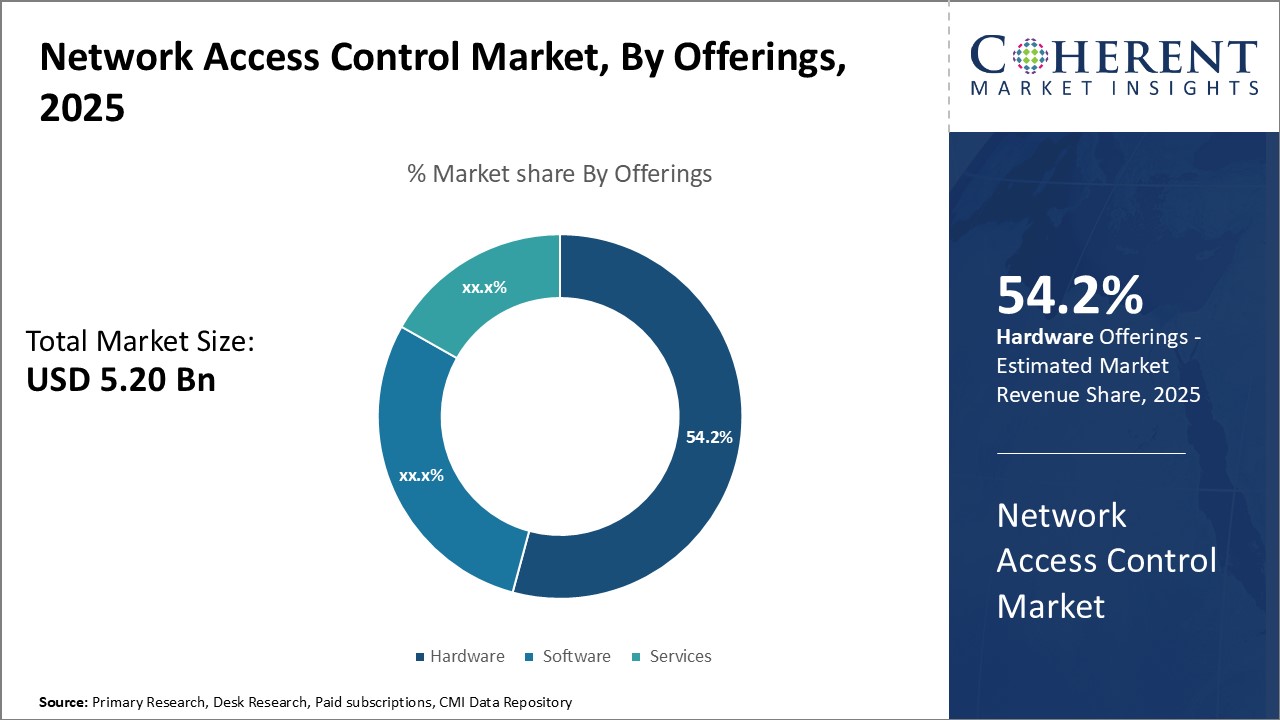
Discover high revenue pocket segments and roadmap to it: Download Free Sample
Insights, By Type- Hardware Dominates Due to Extensive Network Infrastructure RequirementsThe hardware segment currently contributes the largest share within the overall network access control market. It is expected to account for 54.2% of the market share in 2025. Hardware devices such as network access controllers, authentication servers, and associated appliances are critical components that enable user and device identification and access policies. As network infrastructures continue expanding across various enterprise locations and remote work environments, there is considerable demand for hardware endpoints to manage access at the network edge.
Hardware solutions offer organizations robust identity and access functionality including 802.1X port-based authentication, guest access management, and wired and wireless isolation and profiling. This ensures network perimeters remain secured while accommodating a growing number of users, endpoints and traffic volumes traversing different network zones. Hardware devices are also integral to implement segmentation policies that ring-fence high risk applications and sensitive resources on the internal network. Their placement at critical infrastructure junctions makes hardware ideally suited for centralized policy enforcement and visibility.
Furthermore, hardware-based access controls allow for seamless integration with directory services, endpoints management platforms and virtual private network concentrators. Their open interface support facilitates interoperability in hybrid IT environments consisting legacy infrastructure alongside new cloud/SDN architectures. Organizations leveraging hardware can establish a scalable access governance framework that synchronizes with changing business and technical requirements over long implementation lifecycles. This contributes to hardware's enduring popularity even as software-defined access models gain traction.
Insights, By Deployment Type- Cloud Deployment Gains Momentum due to Operational Agility
Within the network access control deployment type segmentation, the cloud model has emerged as the fastest growing segment. It is expected to account for 68.3% of the market share in 2025. Leveraging software-as-a-service and cloud-managed platforms relieves organizations of upfront infrastructure costs and resource overheads associated with on-premises implementations. The cloud delivery method ensures access controls scale seamlessly to address burgeoning user and device volumes without expensive hardware refreshes or additional data centerreal estate.
Cloud-hosted access governance simplifies deployments across global locations and remote user populations that traditional VPNs struggle to support. System updates and new feature releases happen seamlessly in the background, keeping solutions constantly optimized. This operational agility is especially critical as hybrid work policies evolve on an ongoing basis. Outsourcing network access functionality to the cloud eliminates management headaches around upgrades, maintenance, and troubleshooting of on-premise appliances.
Leveraging pay-as-you-grow subscription licensing models, cloud NAC lowers upfront capital expenditures. It provides instant scalability and economizes total cost of ownership in the long run for organizations of varying sizes. The operational expenditures model matched with consumption-based pricing structures facilitate predictable budget allocation for network access governance. These factors are driving more enterprises to opt for cloud-centric access control frameworks to future-proof their networked investment.
Insights, By End-use Industry- Stringent Compliance in BFSI Propels Adoption
Within the end-use industry segmentation of the network access control market, the banking, financial services, and insurance vertical currently accounts for the highest revenue share. It is expected to account for 25% of the market share in 2025. Regulated industries such as BFSI are compelled to demonstrate adherence to rigorous data protection and network security compliance mandates. Network access control solutions have emerged as an indispensable tool for the BFSI sector to enforce regulatory protocols governing user access privileges, traffic inspection, segregation of duties, and forensic logging capabilities.
Financial networks house extremely sensitive customer records, transactional data, and intellectual property. Stringent identity and access management protocols have become table stakes for BFSI organizations looking to safeguard branded reputation and avoid costly non-compliance penalties. Network access control automates the enforcement of compliance-driven security policies throughout distributed infrastructures. It centrally governs the authenticity of users and health of devices gaining entry to business-critical applications networked across data centers, campuses, and branch locations.
Furthermore, guest connectivity challenges in contract-intensive BFSI environments are competently addressed through agentless NAC solutions. Their zero trust capabilities minimize risks of data breach and financial fraud from unauthenticated or malware-infested endpoints. Advanced threat detection and remediation hold special significance for banking networks, making NAC indispensable for maintained a robust security posture. With compliance continuing to heighten across global BFSI regulations, network access governance adoption will remain vital within this core vertical.
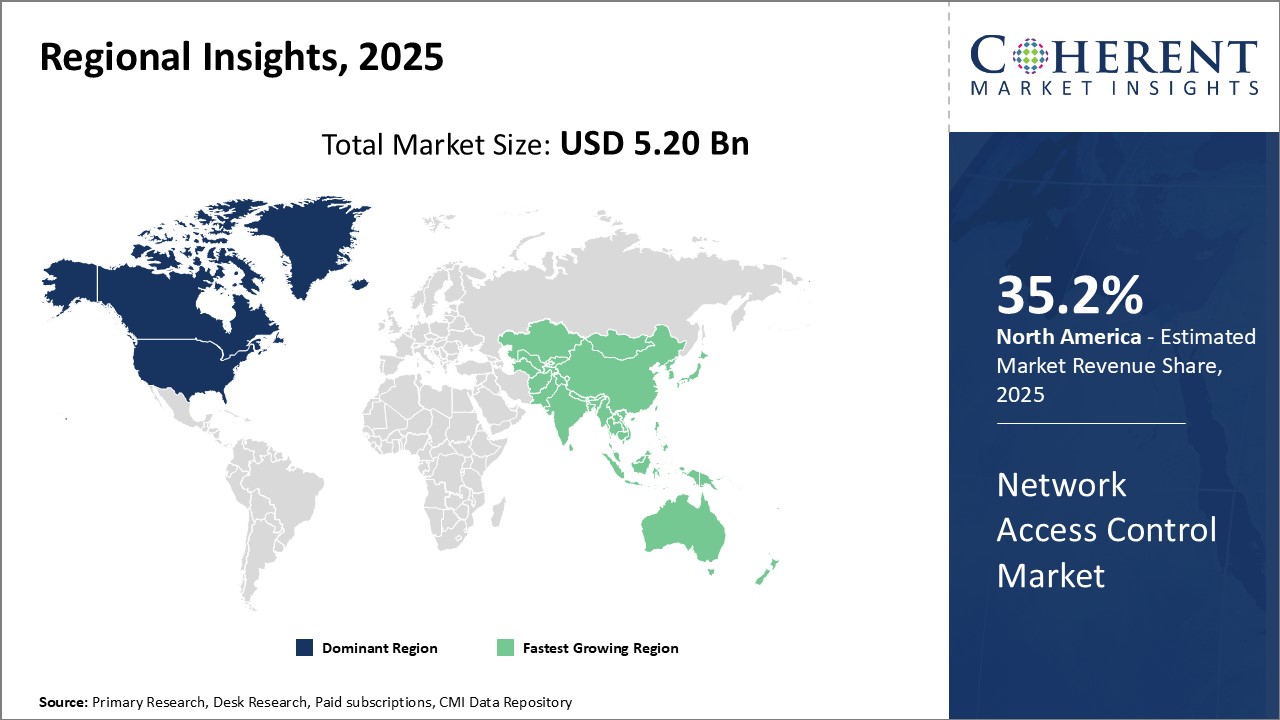
Need a Different Region or Segment? Download Free Sample
North America has dominated the global network access control market. This region is expected to account for 35.2% of the market share in 2025. The strong presence of leading NAC vendors in the region such as Cisco, Aruba, and For eScout has enabled widespread adoption of NAC solutions across various industry verticals like government, BFSI, IT, and telecom etc. The early focus on network security by organizations and the regulatory compliances have propelled the NAC spending. Further, the rich culture of Bring Your Own Device (BYOD) has prompted enterprises to deploy efficient network access management for allowing or restricting device access. The demand has also increased from managed security service providers who offer NAC as part of their security portfolio. This mature and large market creates significant opportunities for vendors to upsell and cross-sell complementary products.
The Asia Pacific region has emerged as the fastest growing market for network access control solutions in recent times. Countries like China, India, Japan, and South Korea are experiencing exponential growth in internet users as well as the number of internet-enabled devices, which has amplified the need for NAC. Additionally, the propagation of digital transformation initiatives across verticals and growing urgency around zero-trust security are major factors driving the market growth. Home to numerous global enterprises as well as over 60.5% of world's population, enterprises in Asia Pacific are proactively deploying network perimeter security to protect against increasing sophisticated cyber-threats. This burgeoning market attracts significant focus from global NAC vendors looking to establish their foothold. Localization of offerings according to the regional compliance needs also aids the market expansion. The network access control solutions are anticipated to experience high demand from both large enterprises as well as small and medium businesses going forward.
Network Access Control Market Report Coverage
| Report Coverage | Details | ||
|---|---|---|---|
| Base Year: | 2024 | Market Size in 2025: | USD 5.20 Bn |
| Historical Data for: | 2020 To 2024 | Forecast Period: | 2025 To 2032 |
| Forecast Period 2025 to 2032 CAGR: | 22.0% | 2032 Value Projection: | USD 20.92 Bn |
| Geographies covered: |
|
||
| Segments covered: |
|
||
| Companies covered: |
Cisco, SAP Access Control, Sophos, Fortinet, Huawei, Extreme Networks, Check Point Software Technology, Microsoft Corporation, Hewlett Packard Enterprises (HPE), Juniper Networks, Inc., IBM Corporation, Broadcom, Inc., ManageEngine, VMware, Forescout Technologies, and Aruba ClearPass |
||
| Growth Drivers: |
|
||
| Restraints & Challenges: |
|
||
Uncover macros and micros vetted on 75+ parameters: Get instant access to report
*Definition: The network access control market provides solutions that enable organizations to control and monitor user access to their networks and systems. NAC solutions help enterprises securely manage employee and guest devices connecting to their networks, whether on-premises or remote. These solutions authenticate users and validate the security posture of devices before granting access. They also allow network administrators to define access policies based on device attributes and user roles to balance security with business needs. Network access control solutions effectively address compliance and reduce security risks for companies.
Share
Share
About Author
Monica Shevgan has 9+ years of experience in market research and business consulting driving client-centric product delivery of the Information and Communication Technology (ICT) team, enhancing client experiences, and shaping business strategy for optimal outcomes. Passionate about client success.
Missing comfort of reading report in your local language? Find your preferred language :
Transform your Strategy with Exclusive Trending Reports :
Frequently Asked Questions
Joining thousands of companies around the world committed to making the Excellent Business Solutions.
View All Our Clients